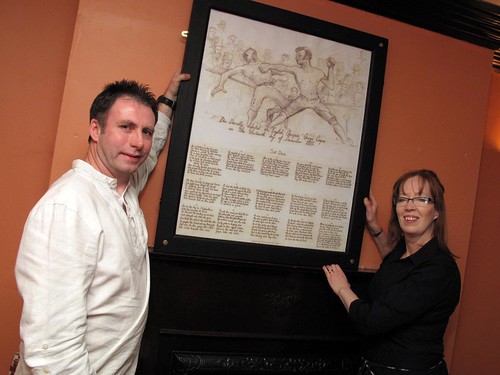Illustrated Donnelly poem in Hideout

An illustrated poem about the saga of 19th century pugilist Dan Donnelly, was presented to The Hideout pub in Kilcullen recently, rather closes a circle in the story, writes Brian Byrne.
Because the poem was written by Barney O'Keefe from Brownstown, the area where the Dublin-born Irish champion fighter trained. And The Hideout has been synonymous with the pugilist ever since his mummified right arm was brought there in the early 50s by then owner of the hostelry Jim Byrne.
These days the arm travels the world on loan from the Byrne family, as part of a major exhibition of Irish fighting heroes. But there is still a strong draw to the pub as the modern folklore home of the fighter's spirit.
"That's why we're delighted to have a unique recollection of Dan Donnelly in Barney's poem," says Clare Boyce, who currently operates The Hideout with her husband Eamonn. "We made Barney's acquaintance when he was involved in the campaign to restore the monument at Donnelly's Hollow after it was damaged last year."
At that time, Clare and Eamonn offered the Hideout's facilities to raise any funds that might be required for the restoration. In return, Barney said they could have the illustrated poem. The framed piece is being given its own special place in the snug of the pub.
"I've been writing poems for years, and I was always interested in the story," Barney said at the presentation. "One day I sat in Donnelly's Hollow and spent some time imagining what had happened there, and how Dan Donnelly's life had gone before and after the event that led to the place being named after him."
That resulted eventually in the writing of 15 verses recalling the pugilist's life and times. At a later stage, Barney asked a Blessington-based artist, Jesse Booth, to recreate in a drawing the epic battle between the Irishman and the English champion, George Cooper.
"I gave him a rough idea of what I had in mind, and when he came back with his own work it was exactly what I wanted," Barney says. "He caught the event perfectly."
The Dan Donnelly poem isn't Barney's only work on display in a significant public place. There's also one in the museum at the Auschwitz 'death camp' in Poland.
"After visiting the camp once, I came away feeling very subdued at the enormity of what had happened there. I eventually wrote a piece based on the feelings of somebody going there today."
He sent the poem to the Auschwitz museum, and after much correspondence relating to his reasons for writing it in the first place, the director of the facility said they would accept the piece, and invited Barney to bring it to Poland.
"They had me present it at the gate of the camp, the most significant place because it was the first sight for all who went in from where they would probably never return."
Barney, a former member of the Defence Forces, has always had a strong interest in local history. But he doesn't just leave it at listening to the stories from family and friends, he has followed many of them up by searching the sites of the tales.
In the process he has recovered lots of memorabilia of history. These include a rare Parnell Medal struck to mark that great Irishman's death, and a talisman of the original Ancient Order of Hibernians. And when the monument in Donnelly's Hollow was damaged last May, he found a old silver box concealed in its foundations.
But his most relevant contribution to Kilcullen will likely be, for many years to come, his poem about a Dublin fighter who probably passed through the village many times, because at that time Kilcullen Bridge was a key passage south out of his native city.
(This piece originally appeared on the Kilcullen page of the Kildare Nationalist.)





























